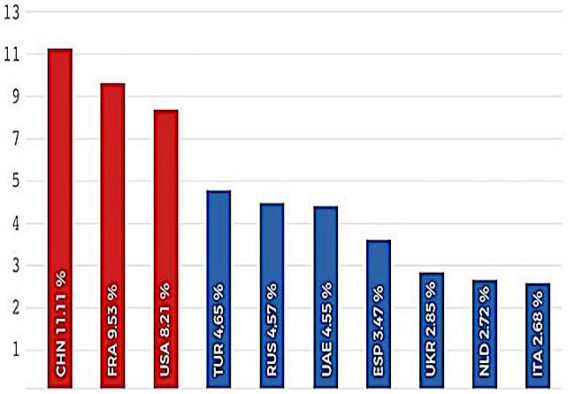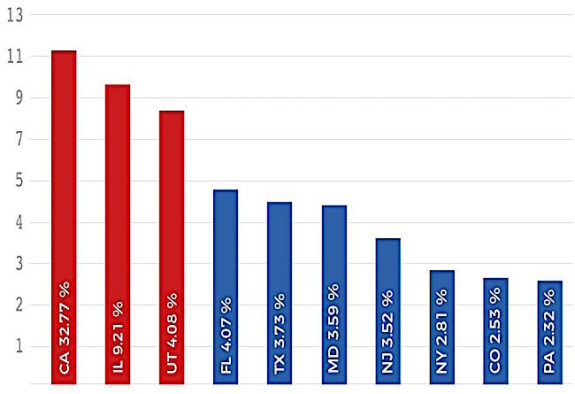Your Images Pirated? Here’s How To Get Paid For Them!
By Arthur H. Bleich–
If you’ve ever posted images on the web–and who hasn’t–chances are someone out there is going to steal them, use them without your permission and not pay you a penny. If they’re used on social media among friends –and for no financial gain– that’s a common scenario and except for asking to have them taken down, there’s not much you can do.

Dubai Skyline. © Novarc Images. Copytrack found this image to have been pirated more than 120 times and recovered thousands of dollars from infringers.
But when a commercial enterprise uses one of your photos without paying you, that’s piracy and it happens all the time because, after all, how are you going to keep tabs on your work when 2 billion images are uploaded and shared online every day?
Enter Copytrack–an image tracking service based in Berlin with offices in New York and Tokyo that has developed some powerful proprietary software to do the job for you; it can even find images that have been altered or cropped.
The company’s revenues are solely derived from getting you paid for unauthorized use of your work. That’s a powerful incentive and, they say, with 85% of those billions of images being used without a valid license, they see a very bright financial future.
The main advantages to using Copytrack, which was launched in 2015, are that they have the legal muscle to prosecute infringement cases in 140 countries and their tracking and recovery services won’t cost you a dime.

Top ten countries (in percentages) that use pirated images according to Copytrack’s records. China, France and the USA are the top infringers.
Yes, it’s free! All you have to do is upload your images and if a hit is made, Copytrack goes to work to get you remuneration taking only a 30% commission on what they recover. If it has to be litigated in court, they’ll do that, too, for a 50% commission.
The company says seven out of ten of U.S. cases are resolved without legal action and the photographer receives a post-licensing fee for the work that has been infringed.
The rest go into litigation but are usually settled out of court because infringers don’t want to risk high legal fees if they lose. Most claims are resolved in about two months, which is when you’ll get your payment.
Here’s how it works. You upload your photos, after which the company’s image recognition software searches the web for photos that match them.
If any are found, you get a report with web addresses you can check out and then select those copyright infringers you want Copytrack to follow up on. Then, sit back and let their team go sic ’em.

Top ten states in the U.S. (in percentages) that use pirated images according to Copytrack’s records. California, Illinois and Utah are in the lead.
Copytrack’s CEO and Founder, Marcus Schmitt visited the U.S. recently and I had a chance to ask him a few questions:
AB: So far, how many pirated images have you found?
MS: The company has discovered more than 2 million unauthorized images out of 10 million hits. Half of these could have been monetized.
AB: I take it, then, that not all have been pursued?
MS: That’s correct. Our engine has a 98% success rate and will find all copies worldwide, but it intelligently excludes all non-valid hits like thumbnails or most private sites.
AB: Why are private sites considered non-valid?
MS: The reason is that we find it inappropriate –bad karma– to go after private individuals. On the other hand, those who are earning money with their web site should not use images of other people without payment. Our software has several smart ways to detect which web sites are business and which are private.
AB: Approximately how many photographers have you recovered fees for so far and what are the monetary results?
MS: We have obtained settlements for more than 5,000 customers. Simple post-licensing recovery fees range from $150 to $500 with the average being $446. More serious infringement cases return $800 to $1,500 and some special cases have yielded fees in excess of $10,000.
AB: In what format must a photographer or artist’s work be uploaded to your site and is there any limitation on how many?
MS: The work has to be uploaded as a JPEG only, with a file size limit of 10 MB for each. Also, not more than 600 pixels on the longest side. As to the number, it is unlimited but we ask that if you are regularly uploading more than a thousand at a time, you contact us first.
AB: What precautions do you take to insure that a photographer or artist’s work will be secure and can’t be stolen from your site?
MS: Our system has the same security standards as banks – SSL certified highest standard.
AB: Are there any other things those who sign up for Copytrack should know?
MS: Anyone can sign up and actually use the service. However if the system detects, that you only search but do not submit cases, we will sooner or later close the account.
The Copytrack web site has tons of information about how to upload your images, how the service works, FAQs, tutorials and articles; it’s well worth spending some time clicking through it. In the end, you might find there’s gold in those pirated images and it won’t require a pick and shovel to extract it because Copytrack’s mining engine and crew can do it faster and better.
RESOURCES
Copytrack’s web site.
Uploading images to Copytrack video.
See the recovery of revenue process here.
To subscribe to Red River Paper’s newsletter, click here.
Original Publication Date: September 29, 2018
Article Last updated: September 29, 2018
Related Posts and Information
Categories
About Photographers
Announcements
Back to Basics
Books and Videos
Cards and Calendars
Commentary
Contests
Displaying Images
Editing for Print
Events
Favorite Photo Locations
Featured Software
Free Stuff
Handy Hardware
How-To-Do-It
Imaging
Inks and Papers
Marketing Images
Monitors
Odds and Ends
Photo Gear and Services
Photo History
Photography
Printer Reviews
Printing
Printing Project Ideas
Red River Paper
Red River Paper Pro
RRP Products
Scanners and Scanning
Success on Paper
Techniques
Techniques
Tips and Tricks
Webinars
Words from the Web
Workshops and Exhibits
all
Archives
January, 2025
December, 2024
November, 2024
October, 2024
September, 2024
August, 2024
July, 2024
June, 2024
May, 2024
more archive dates
archive article list




